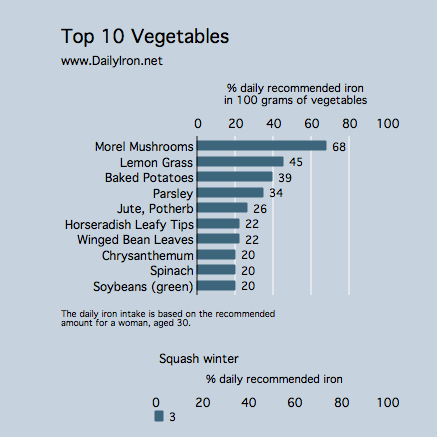Butternut squash contains .60 milligrams of iron per 100 grams. Grams is a measure of weight. To put 100 grams in perspective, consider alternative measures for this food:
- 1 cup equals 205 grams.
In the category of vegetables, we included whole vegetable products in the Top 10 list. We excluded dried/dehydrated products from the Top 10. You will find some dehydrated vegetables high in iron per 100 grams,but they tend to be far more volume than anyone would consume. Furthermore, foods may be fortified with iron but are not included in this Top 10 list. The food tested for the particular graph below can be described more specifically as:
Squash, winter, butternut, cooked, baked, without salt
Read more about iron in vegetables or visit our iron-rich foods list.

Vegetables in general are not an excellent iron source. Those vegetables that do have a lot of iron also have the tendency to be packed with iron inhibitors — you may not take in a large amount of iron from the vegetables.
Nonetheless, even a vegetable with modest amounts of iron can play a substantial part in your absorption of iron. Vegetables are often rich in vitamin C, which can actually help you digest the iron in plant-based foods; butternut squash is a fair source of vitamin C.
As an example, you may wish to incorporate bell peppers and vine ripened tomatoes with a whole grain entree or with legumes to improve your absorption of the iron in your whole meal. A fresh cantaloupe dessert with a meal would help as well because of the vitamins in the fruit itself. A glass of fruit juice is yet another an excellent approach.